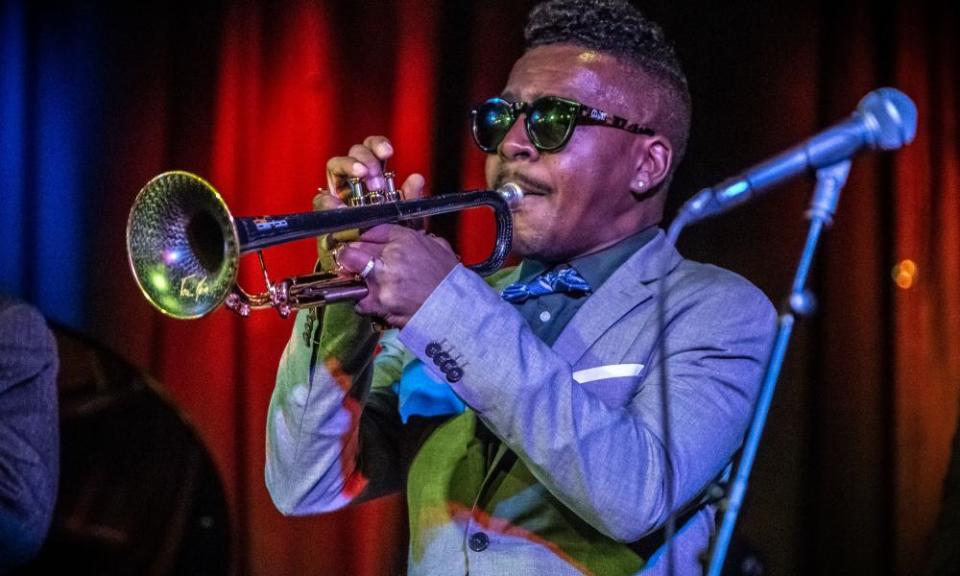Roy Hargrove obituary

When the trumpeter Wynton Marsalis emerged as the champion of a return to traditional acoustic-jazz values in the 1980s, his single-minded charisma inspired talented disciples all over the world. One of the most gifted of them was the trumpeter and flugelhornist Roy Hargrove, who has died aged 49 after a cardiac arrest.
Hargrove began his jazz career in the late 80s sounding as if he could have dropped neatly into a classic Blue Note Records session band of 20 years earlier – and looking like it, too, in his sharp suits, natty hats and shades.
But as the years passed, Hargrove found himself less dedicated to Marsalis’s fastidious avoidance of pop/jazz crossovers – and by the turn of the millennium, he was often working with such creative neo-soul vocal stars as D’Angelo and Erykah Badu, and helping to spur new fusions of jazz, soul, hip-hop and R&B that would bring eager younger listeners to jazz.
Hargrove always sought to deepen his knowledge of African-American music so that – as he once put it to the New York Times – “maybe I’ll be able to develop something that hasn’t been done yet”.
At the Jazz Cafe in London in 2003, when Hargrove introduced his new RH Factor band, and featured soul vocals and hip-hop grooves alongside the jazz swing that had so long preoccupied him, his ensemble sound seemed to bridge that of a D’Angelo R&B outfit, a 60s soul-bop group, and one of Miles Davis’s late-career electric ensembles; but in the same year, he reminded fans of his deep roots when he shared a Grammy award for best jazz instrumental with Herbie Hancock and Michael Brecker for their work on the album Directions In Music.
With Earfood in 2008, his vibrant band of young recruits shrewdly captured the 60s soul-jazz atmosphere unleashed by stars such as Lee Morgan and Horace Silver. But with Emergence a year later, Hargrove’s familiarity with big orchestras surfaced in a sophisticated confection of Ray Charlesian bluesiness, hip Count Basiesque swing, and the floating, vaporous chords of the classic Davis/Gil Evans ensembles.
And though this quiet, slightly built Hargrove was no extravagant showman, he knew how to turn an audience on. At BluesFest in London in 2011, his pin-sharp and fast-moving small-group set included a creditable bow to Nat King Cole on a vocal account of Never Let Me Go, and a crowd-rousing strut like a New Orleans street musician around the Union Chapel on Sam Cooke’s Bring It On Home to Me.
Hargrove was born in Waco, Texas, and raised in Dallas by his parents, Roy, a factory worker, and Jacklyn, a clerical worker. He took up the trumpet at the age of nine after unearthing a pawn-shop cornet belonging to his father, and played funk and R&B at the arts-oriented Booker T Washington high school in Dallas, where he met Marsalis as a visiting tutor.
Marsalis spotted Hargrove’s promise, found him touring opportunities and steered him towards a music education. Hargrove first attended Berklee College of Music, Boston, and then the New School for Social Research, New York, where he was to make his first recordings under the aegis of the saxophonist Bobby Watson.
Hargrove launched a sequence of albums for RCA/Novus with Diamond in the Rough in 1989, and he toured with the Jazz Futures package of rising stars the following year. He guested on Sonny Rollins’s album Here’s to the People in 1991, and led a session of impressive partnerships with illustrious veteran saxophonists including Johnny Griffin and Joe Henderson (With the Tenors of Our Time) in 1994.
Hargrove demonstrated a Marsalis-like mission to spread the jazz message. He leased a loft in Lower Manhattan, New York, in 1992 as a rehearsal space, then developed it into the nonprofit performance venue that became the Jazz Gallery. His mature grasp of the jazz tradition and the achievements of his elders was apparent on the album Family (1995, which included a graceful trumpet duet with Marsalis).
In 1997 he formed the 11-piece band Crisol for a contemporary take on Afro-Cuban music, and won a Grammy award for best Latin jazz album with Habana the following year. Between 1999 and 2002, Hargrove explored a loose but transformative association with the soul and hip-hop-influenced collective Soulquarians in which his trumpet supplied a quiet improvisational commentary on the staccato grooves and soaring vocals around him, notably on such landmark recordings as D’Angelo’s Voodoo (2000) and Badu’s Mama’s Gun (2000).
Hargrove conceived his RH Factor project to pursue these paths in his own ways, but they never usurped his devotion to the jazz tradition, or his belief that while other genres might augment his vocabulary as a player, they could not replace the music he had fallen in love with as a nine-year-old fascinated by his father’s record collection.
Declining health and a prolonged struggle with drugs later distracted Hargrove. He was convicted of cocaine possession in 2014, but according to his manager, Larry Clothier, had been overcoming his dependencies in recent years and continued to tour and frequently sound like his old self. Off the road, he was often to be found sitting in at the Jazz Gallery or at Smalls jazz club on West 10th Street.
Hargrove is survived by his wife, the singer and composer Aida Brandes, his daughter, Kamala, mother, and younger brother, Brian.
• Roy Anthony Hargrove, jazz trumpeter, born 16 October 1969; died 2 November 2018

 Yahoo News
Yahoo News 